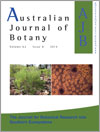Australian Journal of Botany
Volume 62
Number 8 2014
Cryptic species are morphologically similar species that tend to be recognised as a single species. Because the genus Capsella contains two cryptic species (C. bursa-pastoris and C. rubella), our aim was to establish the presence or absence of these exotic taxa in continental Chile. Using molecular markers, we confirm that both species of Capsella are present in continental Chile, although they exhibit different abundances and ranges.
Understanding the timing of seed germination of weeds requires information about the responses of seeds to the environment. We investigated seed dormancy in the weed Turgenia latifolia and found that it consists of two components, one of which could be broken at high and/or low temperatures, and the other, need for embryo growth inside the seed before germination, required low temperature. These results are used to explain how the species can behave as both a winter annual and a short-lived summer annual.
Using four selected molecular markers (nrDNA ITS and the plastid spacers trnS/G, psbA-trnH and trnY/T), we present a phylogeny of Verbascum and test previous infrageneric taxonomic hypotheses as well as its monophyly with respect to Scrophularia. Our results show that while molecular data unambiguously support the circumscription of Verbascum inferred from morphology, they prove to be of limited utility in resolving infrageneric relationships, suggesting that Verbascum ‘s high species diversity is due to rapid and recent radiation.
Epiphytic plants do not have direct connections with the ground. They use trees (phorophytes) as a support, and they are subject to recurrent dry periods. Pleopeltis pleopeltifolia is a poikilochorophyllous desiccation-tolerant (DT) epiphytic fern that has the ability to revive from the air-dry state. So as to better understand the mechanisms of DT in ferns, we carried out a study to analyse changes associated with desiccation and rehydration in P. pleopeltifolia.
The environment and climate that a plant lives in influence its physical traits, and they, in turn, influence plant function. This study investigated the impact of environmental and climatic pressures on the stomata of Dodonaea viscosa subsp. angustissima, so as to discover what environmental and climatic pressures exert greatest influence on stomatal properties. We found that maximum temperature exerted the greatest pressure on the stomata of this species.
Stomata are the interface between the atmosphere and leaf internal spaces, and their size and density can vary with a range of environmental factors. We investigated these responses using Melaleuca lanceolata and found a relationship between stomatal traits and temperature, as well as between leaf width and elevation, rainfall and temperature. Knowledge of leaf plasticity enhances our understanding of how plants respond to changing environmental conditions.
Lack of basic data to assess plant species against IUCN Red List criteria is a major impediment to assigning accurate conservation status throughout large areas of the world. We systematically re-assessed the conservation status of an arid-zone flora using herbarium records, expert interviews and targeted field survey. This approach facilitates robust conservation assessments across vast and poorly known regions, distinguishing species that have been lost in space and time from those that are at risk of becoming lost from our landscape.
Ectomycorrhizal symbiosis with exotic Eucalyptus species is widespread, especially in the semiarid areas compared with arid regions of Punjab Province, Pakistan. This study aims to identify ectomycorrhizal symbionts based on morphotyping and sequence analysis of the rDNA internal transcribed spacer (ITS) region and to assess their potential to colonise different Eucalyptus species. Fungal symbionts are characterised as having a broader host range or narrower host range. Results showed that only three fungal species are evidently colonising the roots of Eucalyptus plantations in the Punjab Province, which reveals that exotic plant species have a narrow host range.
The PAL gene was cloned from Poncirus trifoliata and the sequence analysed using bioinformatics. The expression of pal1 was up-regulated in response to Fe deficiency. Phenolics played a crucial role in alleviation of iron stress in P. trifoliata.




